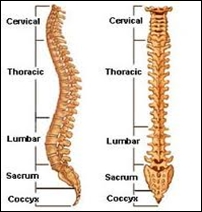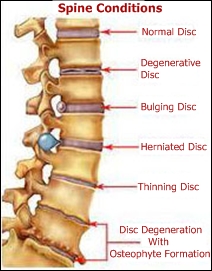THE SPINE
 The Spine is made up of more than 30 individual bones (called vertebrae) stacked on top of one another and joined together by muscles, ligaments and tendons. The vertebrae protect the spinal cord. Between the vertebrae are small discs made of a thick layer of cartilage on the outside and a soft and jelly-like material on the inside. The discs act to absorb shocks caused when the spine moves, and they provide movement and flexibility to the spine as a result of which we can perform actions like bending, twisting, etc.
The Spine is made up of more than 30 individual bones (called vertebrae) stacked on top of one another and joined together by muscles, ligaments and tendons. The vertebrae protect the spinal cord. Between the vertebrae are small discs made of a thick layer of cartilage on the outside and a soft and jelly-like material on the inside. The discs act to absorb shocks caused when the spine moves, and they provide movement and flexibility to the spine as a result of which we can perform actions like bending, twisting, etc.
The spine is divided into 4 sections:
- The cervical vertebrae that make up the neck. Cervical vertebrae are the top 7 vertebrae labeled C1 to C7
- The thoracic vertebrae comprise the chest section/upper back and have ribs attached to them. There are 12 thoracic vertebrae and are labeled T1 to T12
- The lumbar vertebrae form the lower back. There are 5 lumber vertebrae labeled L1 to L5. They start below the last thoracic vertebra and end before the top of the sacrum
- The sacrum and coccyx are the fused bones at the base of the spine
A number of problems can change the structure of the spine or damage the vertebrae and surrounding tissue. They include:
- Infections
- Injuries
- Tumors
- Conditions, such as ankylosing spondylitis and scoliosis
- Bone changes that come with age, such as spinal stenosis and herniated discs
These changes often put pressure on the spinal cord or nerves. This can cause pain and considerably limit the movement of a person. Treatment differs by disease, sometimes back braces and surgery might also be needed.
COMMON SPINAL CONDITIONS
 Slipped Disc- A slipped disc, also known as a prolapsed or herniated or ruptured disc, is where one of the discs in the spine ruptures and the gel inside leaks out. A common symptom of a herniated disc is sciatica, the term used to describe pain, numbness and/or tingling sensation that travels downward along the sciatic nerve from the buttock to the thigh and leg.
Slipped Disc- A slipped disc, also known as a prolapsed or herniated or ruptured disc, is where one of the discs in the spine ruptures and the gel inside leaks out. A common symptom of a herniated disc is sciatica, the term used to describe pain, numbness and/or tingling sensation that travels downward along the sciatic nerve from the buttock to the thigh and leg.
Spondylosis- Degenerative Disc Disease (DDD) or Spondylosis refers to gradual degeneration of the spine. Although it can occur at any spinal level, it most commonly occurs in the lower back region. Degeneration in the cervical region (neck region) is known as cervical spondylosis, while degeneration in the lumbar region (lower back) is known as lumbar spondylosis. . It is a kind of wear and tear disease similar to osteoarthritis. Spondylosis can cause the discs to flatten losing their normal height. This disc height is important as it separates the disc above from the one below. When disc height is lost, the nerve pathways become narrow and cause nerve impingement, inflammation, and pain.
Spondylolisthesis- The word spondylolisthesis is derived from the Greek words spondylo, meaning spine, and listhesis, meaning to slip or slide. Spondylolisthesis is a descriptive term referring to a condition where one vertebra slips over another, causing spine misalignment and instability leading to pain and dysfunction. Spondylolisthesis may be present at birth or develop over time.
Scoliosis- Scoliosis causes a sideways curve of your backbone, or spine. These curves are often S- or C-shaped. Scoliosis is most common in late childhood and the early teens, when children grow fast. Girls are more likely to have it than boys. It can run in families. Symptoms include leaning to one side and having uneven shoulders and hips.
Facet Joint Arthritis- Facet joint osteoarthritis is a process that causes gradual break down of the cartilage between joints. The loss of cartilage causes more friction between the joints, resulting in pain and stiffness. This disorder can also result in compression of nerves, which causes pain.
Spinal Stenosis- Spinal stenosis is a narrowing of the spinal canal or neural passageways (foramina) that can place pressure on nerves in the spinal cord. Stenosis is a result of aging, and wear and tear of the spine.
Osteoporosis- Osteoporosis is a disorder caused by bone mineral loss that results in fragile bones. This disorder can cause vertebral compression fractures or a humped back.
Spinal Tumors- A spinal tumor or a growth of any kind - whether cancerous or not, can impinge on nerves, leading to pain, neurological problems and sometimes paralysis. The symptoms include loss of sensation or muscle weakness, especially in the legs, difficulty in walking, sometimes leading to falls and loss of bowel or bladder function.
In addition to these common conditions associated with back pain, there are many other possible causes like pregnancy, injury, infection and tumors. Pregnancy stresses the back and may contribute to pain that lasts several months, but generally this pain subsides and is not indicative of a chronic condition. In any case, persistent pain requires that the sufferer seek a more specific and definable problem after a wait-and-see period has elapsed.
MOST COMMON SPINE SURGERIES
Discectomy and Microdiscectomy- Discectomy is a surgery to remove the central portion of an inter-vertebral disc, the nucleus pulposus, which might be causing pain by pressing on a nerve root or the spinal cord. After the herniated disc is removed it reduces the pressure on the nerves and relieves the pain. Microdiscectomy uses a special microscope to view the disc and nerves. This enables the surgeon to use a smaller cut. This causes less damage to surrounding tissue.
Foraminotomy- The procedure relieves pressure on nerves that are being compressed by the inter-vertebral foramen (i.e. the passageway from where a nerve root exits the spinal canal). In foraminotomy apart from a herniated disc a portion of bone and other tissue might also be removed.
Spinal Fusion- Spinal fusion is a surgery to join, or fuse, two or more vertebrae. It is done to eliminate motion between adjacent vertebrae. It is an option when motion is the source of pain for e.g. to treat spondylolisthesis (unstable spine).
Spinal Disc Replacement- Spinal disc replacement is done to treat specific types of back pain, while avoiding the problems associated with spinal fusion surgery.
Anterior Cervical Corpectomy- When the cervical disease encompasses more than just the disc space, the spine surgeon may recommend removal of the vertebral body as well as the disc spaces at either end, to completely decompress the cervical canal. This procedure is often done for multi-level cervical stenosis with spinal cord compression caused by bone spur (osteophytes) growth.
Cervical Spine Surgery- Cervical spine surgery is performed for variety of cervical spine problems. Generally, surgery may be performed for degenerative disorders, trauma or instability. These conditions may produce pressure on the spinal cord or on the nerves coming from the spine. The goal of this surgery is to relieve pain, numbness, tingling and weakness, restore nerve function and prevent abnormal motion of the spine.
Lumbar Laminectomy- Lumber Laminectomy is a surgical procedure most often performed to treat leg pain related to herniated discs, spinal stenosis, and other related conditions. The goal of a laminectomy is to relieve pressure on the spinal cord or spinal nerve by widening the spinal canal. This is done by removing or trimming the lamina (roof) of the vertebrae to create more space for the nerves.
Endoscopic Spine Surgery- Endoscopic spine surgery is an operation on the lumbar spine performed using a surgical endoscope and microsurgical techniques. This type of surgery is performed by orthopedic surgeons and neurosurgeons who are experts in diagnosing the causes of back and neck pain and recognizing when a patient is likely to get better with surgery.
Vertebroplasty- Vertebroplasty is a procedure in which a special type of synthetic cement material is injected inside the broken spine bone, giving excellent results in pain relief with very low incidence of side effects. This procedure can be safely done in osteoporotic fractures, painful spine bones after spread of cancer, non cancerous painful tumors of spine bones or to augment strength of weak spine bone prior to insertion of screws to increase the holding power of the weak bones for other surgical procedures.
| ALL PRICES IN USD ($) ONLY |
| Procedure |
USA |
UK |
India |
Thailand |
| Cervical Disc Replacement (with implant) |
13500 |
13000 |
8500 |
13000 |
| Spinal Fusion |
62000 |
65000 |
6000 |
70000 |
#IVF, #IVF in India, #Fertility Treatment, #Fertility Treatment Abroad, #Infertility, #Infertility Treatment Abroad, #Surrogacy, #Surrogacy in India, #Savings, #Affordable Healthcare, #ICSI, #ICSI in India, #India, #Paradigm Healthcare, #Medical Travel, #Medical Tourism, #Treatment Abroad, #Treatment in India, #Surgery, #Low Cost Surgery, #Best IVF, #Best Surrogacy, #IVF Clinic in India, #Rotunda, #Kaberi Banerjee, #Rita Bakshi, #International Fertility Centre, #Indira Hinduja, #Gautam Allahbadia, #Dr.Malpani, #Shivani Sachdev, #Nova Fertility, #Shweta Mittal, #Anoop Gupta, #Dr.Pai, #Fertility Specialist, #Doctors, #Surgeons, #Gay Surrogacy, #Highest Success Rate in IVF, #Highest Success Rate in Surrogacy, #Low Cost Surrogacy, #Best Prices, #Best Quality, #Egg-Donor, #PGD, #Pre-implantation Genetic Diagnosis
IVF | IVF in India | ICSI | IUI | Surrogacy | Surrogacy in India | Medical Travel | Medical Tourism